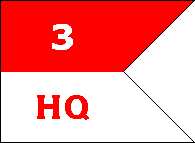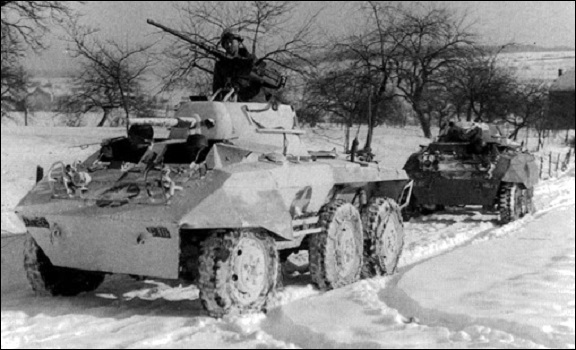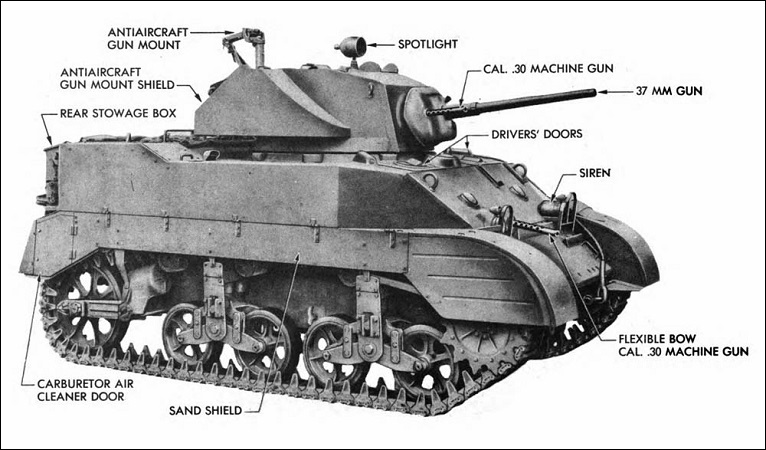By the mid-1930s the US Army had
accepted that the era of the horse cavalry was drawing to a
close. It was planned gradually to mechanize the cavalry,
replacing horses with tanks, armored cars and other
vehicles, and it was in the Cavalry branch that the idea of
the armored division first took shape. But lack of money
prevented very much from being done. Armored cars and light
tanks were procured in limited numbers, but it was not until
the beginning of World War II that the desired
transformation was commenced.
But on 7
December 1941 the mechanization of the US Army’s cavalry
regiments was not yet complete. Those of the Army’s two
cavalry divisions were still mounted on horses, while most
of the nondivisional regiments were designated horse and
mechanized, with one horse cavalry squadron and one
mechanized cavalry squadron. The regimental headquarters and
service troops of these regiments were were also
mechanized. The nondivisional
regiments were considered corps-level reconnaissance units
and their horse cavalry squadrons were to be mechanized as the
required equipment became available.
The
mechanized squadron had a headquarters troop, two
reconnaissance troops and a motorcycle troop. The
reconnaissance troops’ principal equipment was the M3A1
Scout Car (SC). This was a four-wheel-drive vehicle with
light armor and an open-topped crew compartment, armed with
one .50-caliber heavy machine gun (HMG) and two .30-caliber
medium machine guns (MMG) mounted on a skate rail. Each
recon troop had 16 x SC and 23 x motorcycles. The motorcycle
troop had 10 x SC and 32 x motorcycles.
The
Cavalry Regiment (Horse and Mechanized) was a transitional
organization with various deficiencies. The principal one,
of course, was the awkward combination of mounted and
mechanized sub-units. But the regiment was also deficient in
firepower. Except for a motor-towed antitank platoon in the regimental
headquarters troop with 6 x 37mm antitank guns (ATG), there
were no weapons heavier than the .50 caliber HMG. Nor did
the M3A1 SC prove itself entirely satisfactory. Its off-road performance
was indifferent, and with its thin armor and open-topped
crew compartment the M3A1 was vulnerable even to small-arms fire
and grenades. Thus when the regiments were fully mechanized
in 1942-43, a number of changes were made.

Guidon of Headquarters &
Headquarters Troop, 3rd Cavalry Regiment
The
Cavalry Regiment (Mechanized), whose table of organization
was approved in April 1942, had four reconnaissance troops,
two support troops and a regimental service troop. The two
squadron headquarters troops were reduced in size, some of
their assets being reallocated to the recon troops. They now
functioned purely as tactical headquarters to which recon
and support troops could be assigned according to mission
requirements. This organizational scheme was somewhat
similar to that adopted for armored divisions: two
combat command headquarters controlling a variable number of
sub-units as required.
The recon troops had a headquarters platoon with 3 x SC and
three recon platoons each with 2 x SC, 2 x 37mm ATG and 1 x
81mm mortar, for a troop total of 9 x SC, 6 x 37mm ATG, and
three 81mm mortars. The two support troops each had three
tank platoons, each with with 5 x M5 light tanks (37mm gun) and a
self-propelled assault gun (SPAG) platoon with 3 x T30
halftracks mounting a 75mm howitzer. Throughout the
regiment, motorcycles were largely replaced by halftracks
and 0.25-ton trucks: the ubiquitous Jeep. The revised
organization and the addition of tanks, additional ATG and
mortars enhanced the regiment’s tactical flexibility and
considerably augmented its firepower. The retention of the
M3A1 SC was something of a drawback, but a replacement, the
M8 Armored Car (AC) was already in production.
As
things turned out, however, the April 1942 organization did
not last long enough for all cavalry regiments to undergo
conversion. In early 1943 the Army decided to abolish the
regiment as a tactical unit in all branches except Infantry.
Its replacement was the group: a headquarters unit to which
independent sub-units could be attached as required. For the
existing regiments of the Cavalry branch the changeover was
accomplished as follows (using the 4th Cavalry Regiment as
an example). The regimental headquarters troop became
Headquarters and Headquarters Troop (HHT), 4th Cavalry Group
(Mechanized); the 1st Squadron became the 4th Cavalry
Reconnaissance Squadron (Mechanized); and the 2nd Squadron
was renumbered as the 24th Cavalry Reconnaissance Squadron
(Mechanized). In principle these were all independent units,
though in practice the two squadrons were attached back to
the group and usually stayed with it. The cavalry group,
like the cavalry regiment it replaced, was a nondivisional
unit, assigned at corps level. But armored and
infantry
divisions also had mechanized cavalry units: a squadron for
the former and a reconnaissance troop for the latter.

December, 1944: M8 armored
cars on the move during the Battle of the Bulge (US Army Center
of Military History)
The new
separate Cavalry Reconnaissance Squadron (Mechanized) had an
HQ troop, three reconnaissance troops, a light tank troop and an
assault gun troop. The squadron for armored
divisions was in most respects identical to the squadrons
attached to cavalry groups, but it had four rather than
three reconnaissance troops and a fourth platoon in the assault gun
troop. The separate reconnaissance troop for infantry divisions was
identical to those in squadrons. By 1944 the M3A1
SC had replaced by the M8 AC, and the T30 halftrack SPAG had
been replaced by the fully tracked M8. This latter vehicle was
based on the M5 light tank, with a 75mm howitzer in an
open-topped turret. The light tank troop was equipped with
the M5A1 Stuart light tank, armed with a 37mm gun and three
.30-caliber MMG.
The
basic mechanized cavalry unit was the Cavalry Reconnaissance
Troop (Mechanized). It consisted of a headquarters
section and three platoons, each with an armored car section
and a scout section. The former had 3 x M8 AC; the latter
had 6 x Jeeps, 3 x .30-caliber MMG and 3 x 60mm mortars. In
total the troop had 12 x M8 AC, 3 x .50-caliber HMG, 13 x
.30-caliber MMG and 9 x 60mm mortars. The Light Tank Troop
had 17 x M5A1 light tanks and the Assault Gun Troop had 6 x
M8 SPAG. Thus by 1944 the Army’s mechanized cavalry units
were highly mobile and well armed, though the combat experience
acquired between D-Day and VE Day disclosed some lingering
deficiencies.
Though
the M8 AC was an improvement over the M3A1 SC,
its off-road performance was even less satisfactory
than the vehicle it replaced. Though its 37mm gun was
capable of destroying any German reconnaissance vehicle, the
M8 was vulnerable to the 20mm guns with which the latter
were mostly armed. On the other hand, the M8’s on-road
performance was exceptional, its six-cylinder gasoline
engine giving it a top speed of 55 mph. The engine also ran
quietly, a desirable feature in a reconnaissance vehicle.
Finally, the fact that it was wheeled rather than tracked
meant that the M8 was easier to maintain than its stable
mate, the M5A1 light tank.
Like the
M8, the M5A1’s main armament was 37mm gun — which by 1944
was marginally effective at best against German tanks. It
could damage a Panzer IV, but against a Panzer V (Panther)
or Panzer VI (Tiger) tank the 37mm gun was hopelessly
inadequate. One solution was to attach a medium tank company
or a self-propelled tank destroyer company to the cavalry
group, but these were not always available. A replacement
for the Stuart light tank had been in development since
mid-1943: the M24 Chaffee. Though lightly armored, the
Chaffee was armed with a 75mm gun—a vast improvement over
the puny 37mm. M24s began to reach the cavalry in late 1944,
but only a handful saw action before the war came to an end.

The M5A1 Light Tank as
depicted in a wartime US Army technical manual
During
the campaign in northwest Europe, each US corps usually had
a cavalry group attached, and others were held at army
level. During the Battle of the Bulge many cavalry units
were heavily engaged in defensive fighting for which they
had never been intended, and suffered heavy casualties. The
cavalry played a prominent role in the last offensive into
Germany and postwar several cavalry groups were incorporated
into the United States
Constabulary. The Constabulary was an Army command responsible for
maintaining law and order in the American zone of occupied
Germany
pending the reconstitution of a German police force, and
performed this duty until 1952.
The
lessons learned through the mechanization and reorganization
of the cavalry and its combat employment in World War II led
eventually to the development of the Cold-War-era Armored
Cavalry Regiment, which integrated armor, mechanized
infantry, field artillery and helicopters in a potent
combined-arms team.